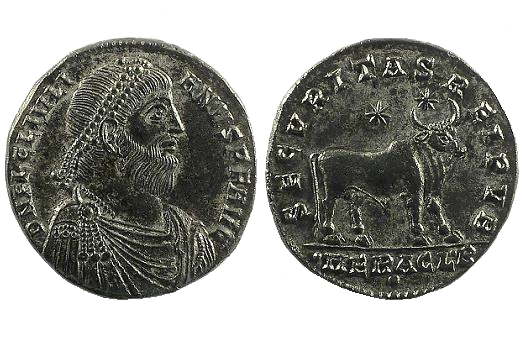
about ancient nomos
Ancient Nomos Art is a museum of galleries exhibiting ancient coins and ancient mint maps. The coin gallery displays the diverse art and history of hand-crafted ancient Greek, Roman, Byzantine, Persian and Medieval coinage. The ancient mints mapping gallery features Greek, Roman, Byzantine, Asia Minor and Medieval mint city regions and territories. Visitor's are welcome to explore, study and enjoy Ancient Nomos Art.

Imperial, Roman – 361 AD
Julian II
From Ancient Galleries

Obverse: Emperor Julian II facing right, pearl-diademed, draped and cuirassed.
Reverse: Large horned bull standing to the right, two Dioscouri stars above.
LEGEND
Obv: D N FL CL IVLI-ANVS P F AVG, Julian II facing right, pearl-diademed, draped and cuirassed. Rev: SECVRITAS REIPVB•, Horned bull standing right, two stars above; •HERACL•B• below.
Born Flavius Claudius Julianus in late spring of 332 AD, Julian II was the son of Constantius, the half brother of Constantine the Great. He was very well educated and thoroughly studied in Neoplatonic theology under Aedesius the philosopher, followed by Maximus of Ephesus. Due to threats against the Empire, his father Constantius was forced to install Julian as Caesar of the West Empire in 355 AD. As Caesar, Julian learned the art of warfare and quickly triumphed through successful military campaigns against Germanic Tribes. Six years later he was proclaimed emperor by the death of Constantius in 361 AD. As the last non-Christian ruler of the Roman Empire, Julian aspired admirably to bring back Pagan beliefs, where the gods and their representative myths, are the omni-perfect mediators between the individual, the world, and the after life. His coinage reflects this effort by the obverse depicting Julian’s portrait bust wearing a deliberately long beard of an ascetic Pagan philosopher, contrasting his clean shaven predecessor. He is draped in the usual purple, cuirassed and wears his pearl diadem. The coin reverse depicts a horned bull standing right, with the latin legend SECVRITAS REIPVB, meaning “Security of the Republic” above. Two star symbols are located above the bull, with mint location “Heraclea” below, flanked by three dots. The bull motif has elicited many interpretations since issued in 361 AD. It has been suggested that Julian’s choice to depict a bull might represents the Apis Bull, a Pagan cult statue from Egypt thought to have been in his possession (Ammianus). Or that it reflects the Mithraic bull, sacrificed before the gods to become earthly forms, with stars alluding to the Dioscouri (Athanassiadi). The bull is thought to also signify Julian’s May birth sign Taurus, with stars Pleiades and Hyades, the two stars in this constellation. Julian’s coin marks the last Pagan symbols issued by the Roman Empire.
DOCUMENTATION
Value: AE1. Metal: AE Bronze. Weight: 8.55 grams. Mint: Heraclea, Thrace. Date: 361-363 AD.
Attribution: Roman Imperial Coinage, VIII 104; Carson, Late Roman Bronze Coinage, 1910.
Legend, Documentation and Attribution
